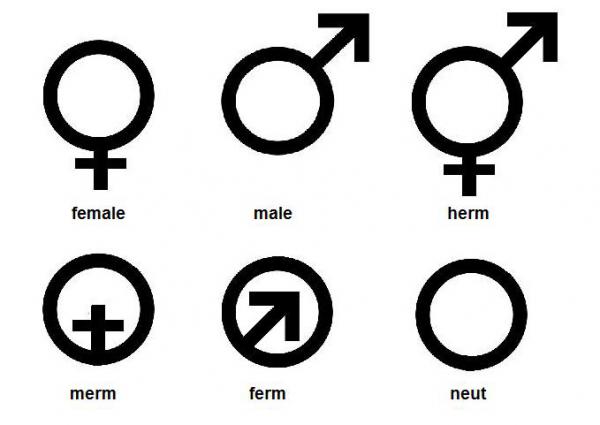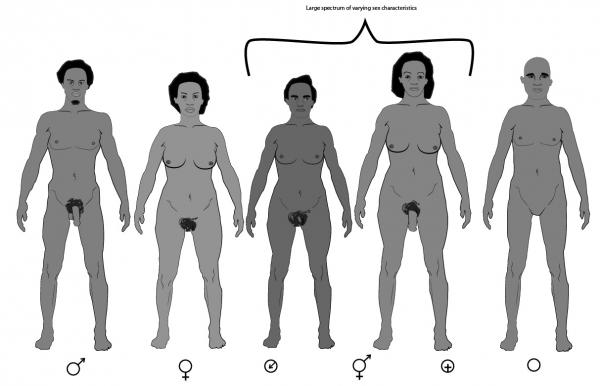BY LETTER
Sex and Sexuality
Science > Biology
Culture and Society > Family and Community > Childrearing
Culture and Society > Cultures and Sub-Cultures
Culture and Society > Family and Community > Marriage
Culture and Society > Family and Community > Childrearing
Culture and Society > Cultures and Sub-Cultures
Culture and Society > Family and Community > Marriage
 Image from Steve Bowers |
Common Definitions
Biological Sex
Sex refers to a set of biological, or embodied attributes in presapient, sapient, modosophont and some transapient creatures. It is primarily associated with physical and physiological features including chromosomes, gene expression, hormone levels and function, and reproductive/sexual anatomy. Sexes are frequently categorized as "asexual", "female", "male", "hermaphrodite", or a variety of other types used for natural reproduction. Clades using more decentralized reproductive systems, especially non-biological clades using assembly-line processes, often use a more modular approach. In most developed sephirotic societies, the possibilities of morphological freedom allow sophonts to achieve any desired combination of features, which may or may not match their gender identity, or necessarily be used for reproduction, for a variety of reasons. Sophonts can also easily change their sex over short or long timespans to align with, or diverge from, their own gender identity or their culture's gender roles (if it maintains any) as well.Sexual Orientation
Sexual Orientation is a pattern of romantic or sexual attraction (or a combination of these) to persons of a different sex, gender, or species, the same sex, gender, or species, or a variety of sexes, genders, or species. These attractions may be categorized under the concepts of heterosexuality, homosexuality, bisexuality, (species)sexuality, pansexuality, omnisexuality, polysexuality or asexuality.Gender
Gender refers to the social roles, behaviours, psychological expressions and identities generally associated with reproductive instincts or programming for sophonts who experience and use these concepts. It sometimes influences how sophonts perceive themselves and each other, how they act and interact, social and behavioral expectations they're assigned, and may affect the distribution of power and resources in some (usually primitive) societies. Gender identity is rarely confined to a binary (masculine/ feminine, etc) or even necessarily the six genders identified with the six standard Anglish pronouns (male, female, herm, merm, ferm, neut), nor is it static; it exists across a conceptual landscape and individuals can change their identities and expression over time, sometimes over years, sometimes day to day, sometimes moment to moment. There is considerable diversity in how individuals and groups understand, experience and express gender through the roles they take on, the expectations placed on them, relations with others and the complex ways that gender is institutionalized in society.Some clades use complex gender systems that diverge from the six standard hu genders. For example, the Tensepathraa, a clade of insectoid neogens, were designed with no less than 17 sexes by their creators, a team of bioartists from the Zoeific Biopolity. Each offspring has anywhere from 4 to 9 parents, with a complex system of compatibility describing which matings and in what order result in reproduction. Their language has corresponding declined forms for each gender.
Many other clades and societies do not have genders. This phenomenon is common amongst nonbionts, vecs and aioids, groups who may find categorization based on traits associated with having certain sexual organs (instead of, say, based on age or occupation or operating system) to be farcical.
In the vast majority of Sephirotic and associated societies, though a sophont may have a gender, they are not restricted by it. In some other societies, especially those outside the Civilized Galaxy and dominated by bionts, gender roles may exist with varying degrees of rigidity.
Even when an individual can be classified under one of the six standard hu genders, the grammatical pronoun used may not necessarily correspond to the 'standard' gender they are classed under. If contrary to the category placed in according to the table, individual or cultural idiosyncratic preferences for gender-specific pronouns should be given priority over the standard usage. It is common advice that one should never correct the chosen grammatical gender based on the standard, since in many Terragen cultures this can be considered offensive to varying degrees. Most citizens use "public profiles" or "metadata" that anyone's DNIs can incorporate into understanding new people consciously or unconsciously, at a glance. Most introduction and identification protocols will indicate the correct gender, if one is used.
 Image from Worldtree |
The following forms are the six 'standard' biological sexes (which have corresponding standard genders) common in the bionts of terragen society. Many other sexes beyond Male, Female, Merm, Ferm, Herm, and Neut exist as well.
Any hu sophont changing between any two of the sexes as a clade or peer mark, or as a lifestyle choice, can use a combination of bionano, nanomedibots, and specific hormone treatment to alter the biological organs if their respective clade is not capable of changing within the parameters of their genetic programming.
Female
Female is the physiological sex of an organism, or a part of an organism, that produces non-mobile ova (egg cells). Female characteristics vary between different species with some species containing more well defined female characteristics, such as the presence of pronounced mammary glands. Barring rare genetic defects, most female mammals, including female nearbaseline humans, have two X chromosomes.Male
Male is the physiological sex of an organism, or a part of an organism, that produces the sperm gametes. A male gamete can fuse with a larger female gamete, or ovum, in the process of fertilization. A male cannot reproduce sexually without access to at least one ovum from a female, but some organisms can reproduce both sexually and asexually. Most male mammals, including male humans, have a Y chromosome, which codes for the production of larger amounts of testosterone to develop male reproductive organs.Herm (Hermaphrodite)
Herms have both male and female sexual organs, but their secondary sexual characteristics vary from individual to individual, ranging from fully male to fully female or a mixture between the two. When occurring naturally among baselines and other hu clades (usually in prim or other non nanotech environments) this is most often caused by an unusual condition whereby both testicular and ovarian tissue develop. Chromosomes may be either XX, XY, or a mosaic of the two. Hermaphroditism is a common and natural trait among many terragen and xenobiotic life-forms.Hermaphrodites sometimes also describe themselves as 'ambigenital', 'bigonadal' and 'monoecious' in individuals who possess multiple reproductive organs at the same time, as opposed to sequential hermaphrodites who automatically alternate between sexes.
Ferm (Female Pseudohermaphroditism)
A Ferm has male secondary sexual characteristics and female sexual organs.When occurring naturally among baselines and other hu clades (usually in prim or other non-nanotech environments) this is female pseudohermaphroditism, most often caused by a missing enzyme, which causes over stimulation of the adrenal gland, overproduction of androgen, and alteration of the genitals. Chromosomes are XX and individuals with this condition have ovaries and are genetically female.
Merm (Male Pseudohermaphroditism)
A Merm is a male individual with the secondary sexual characteristics of a female.When occurring naturally among baselines and other hu clades (usually in prim or other non nanotech environments) this is male pseudo-Hermaphroditism, most often caused by a defective gene that prevents genetically male (XY chromosome) fetuses from absorbing androgen. The foetus develops testes, but otherwise continues to develop along female lines, although the vagina is often underdeveloped and there is no uterus.
Nonsexual merms may feel "gender neutral" and often prefer the company of other merms, while sexual merms have a range of sexual behaviors open to them.
Neut (Neuter)
Neuts have reduced their genitalia and secondary sexual characteristics to an undeveloped state, or removed them altogether.Popular among extreme religious and monastic clades, and various eccentric and situationist groups, clades, and movements, and (as a temporary or permanent choice) lifestyle among transmogrifists. Neuts who do not have any sexual feelings whatsoever are known as asexuals; however not all neuts have no sexual feelings, and some indeed have rich and fulfilling (and often ingenious) sex lives. Neut modifications are (of course) not inheritable through non-technologically assisted reproduction.
Asexuality in terragen sophonts may be a natural physio-psychological trait in any biological sex (in males, females, etc), or a deliberate act of psychological, neurological, and physiological modification. Some Terragens choose to use bodysculpting and psychoware to remove all sexual attributes and feelings. These neut asexuals are a subdivision of the commonly recognised neut biological sex, and are defined as neuts (neuter sophonts) who do not have any form of sexual desire.
Note that (unlike neut asexuals) a small, but significant, number of neuts are capable of sexual desire, even lust, despite having no sexual organs. Such individuals are often capable of having satisfactory sex lives.
Although they do not 'lust' for one another, asexuals can and do have feelings of platonic love and many feel joy at having children. In order to have children, neut asexuals can adopt, or use cloning or artificial genetic blending to produce offspring. Since they have no reproductive organs they must use artificial reproduction technology or engeneration to produce their offspring.
In some forms of anglish, the word 'Asexual' can refer to the sexuality (Does not experience sexual attraction, but may or may not still experience romantic attraction), or a biological reproductive method by vegetative propagation, by parthenogenesis or by fission. Many terragen organisms (such as lower animals, plants, and microbes) and Numerous xeno species of all kinds reproduce via parthenogenesis. Most languages differentiate between the two terms.
 Image from Anders Finer (copyright; used with permission) | |
| A merm with the secondary sexual characteristics of a female, despite male sexual organs. | |
Common Features of Biological Sexes
The following table should only be used as a rule of thumb for identification and use of sexes, primarily for hominid, or at least mammalian, clades.| Can naturally bear children? (ie, has female primary sexual characteristics) | Can naturally contribute genetic material to others' borne offspring? (ie, has male primary sexual characteristics) | Has female secondary sex characteristics? (e.g., in humans, enlarged breasts and lack of facial hair. Non-hominid clades often use a different variety of features to make this differentiation: manes, tusks, antlers, colours, etc.) | |
| herm | yes | yes | yes |
| herm | yes | yes | no |
| female | yes | no | yes |
| ferm | yes | no | no |
| merm | no | yes | yes |
| male | no | yes | no |
| neut | no | no | yes |
| neut | no | no | no |
Related Articles
- Cymbiotic
- Dionysan Erotocracy
- Erotobot - Text by M. Alan Kazlev
A bot designed for erotic or sexual purposes. - Erotogen
- Ferm - Text by M. Alan Kazlev, Daniel Eliot Boese
One of six standard hu Sexes, the others being male, herm, merm, female, and neut. A Ferm has male secondary sexual characteristics and female sexual organs. - Herm - Text by M. Alan Kazlev, Daniel Eliot Boese
Hermaphrodite, one of six standard hu sexes and genders, the others being male, merm, ferm, female, and neut. Herms have both male and female sexual organs, but their secondary sexual characteristics vary from individual to individual, ranging from fully male to fully female or a mixture between the two. - Hybrid
- Keymales
- Merm - Text by M. Alan Kazlev, Daniel Eliot Boese
One of six standard hu sexes, the others being male, herm, ferm, female, and neut. A merm is a male individual with the secondary sexual characteristics of a female. - Neut - Text by M. Alan Kazlev, Daniel Eliot Boese, Steve Bowers
One of six standard hu sexes and genders, the others being female, ferm, herm, merm, and male. Neuts have reduced their genitalia and secondary sexual characteristics to an undeveloped state, or removed them altogether. Note, however, some neuts may have active sex lives even without functioning sexual apparatus, and some present as male or female. - Parthene, Clade
- Pronouns, Early Anglic
- Reproductive Counselors
- Reproductive Technologies
- Technogamy
Appears in Topics
Development Notes
Text by Michael Beck, with additions by Steve Bowers
updated by Todd Drashner 5-29-18
Initially published on 07 October 2001.
————
Text of original articles by M. Alan Kazlev & Daniel Eliot Boese- Initially published on October-December 2001.
Charts and symbol illustration added in 2011 by Steve bowers.
Human illustration added 2017 by Dfleymmes
Updated by Todd Drashner 5-29-18.
All six sex articles combined, edited, and Gender + sexuality sections added in November 2020 by Dfleymmes.
updated by Todd Drashner 5-29-18
Initially published on 07 October 2001.
————
Text of original articles by M. Alan Kazlev & Daniel Eliot Boese- Initially published on October-December 2001.
Charts and symbol illustration added in 2011 by Steve bowers.
Human illustration added 2017 by Dfleymmes
Updated by Todd Drashner 5-29-18.
All six sex articles combined, edited, and Gender + sexuality sections added in November 2020 by Dfleymmes.






